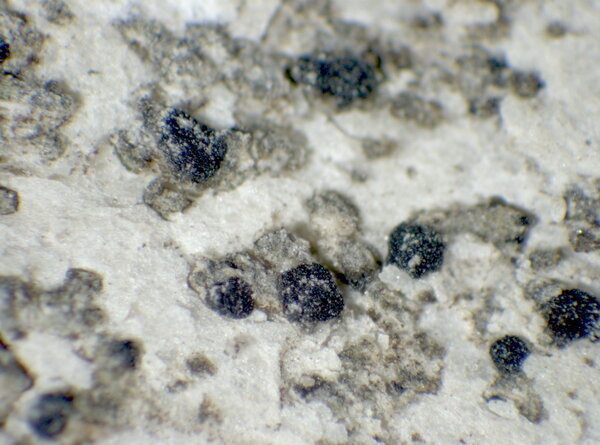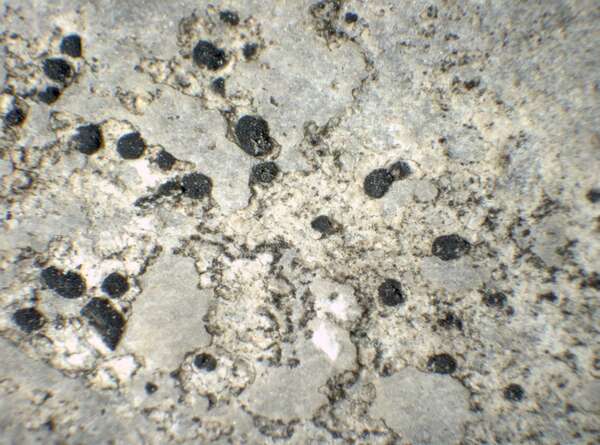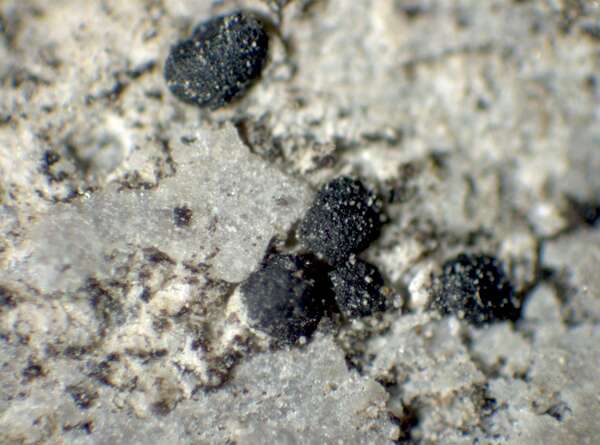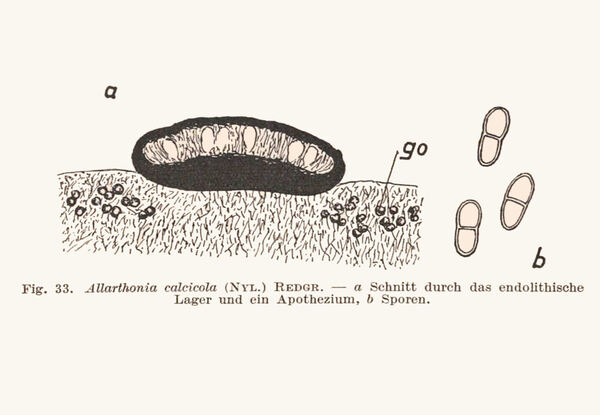Arthonia fusca (A. Massal.) Hepp
Flecht. Europ.: 534, 1860. Basionym: Catillaria fusca A. Massal. - Ric. Auton. Lich. Crost., 80, 1852.
Synonyms: Allarthonia fusca (A. Massal.) Sandst.; Allarthonia lapidicola auct. non (Taylor) Zahlbr.; Allarthonia lapidicola var. ruderella (Nyl.) B. de Lesd.?; Arthonia koerberi (J. Lahm) Malbr.; Arthonia lapidicola auct. non (Taylor) Branth & Rostr.; Arthonia ruderella Nyl.; Arthonia vagans Almq. var. koerberi (J. Lahm) Almq.; Catillaria ooliticola Walt. Watson; Coniangium fuscum (A. Massal.) A. Massal.; Coniangium rupestre Körb.
Description: Thallus crustose, thin and mostly poorly evident, endosubstratic or thinly episubstratic and then continuous to scurfy, grey-brown. Apothecia arthonioid, emarginate, innate to adnate, angular or rounded, up to 0.5(-0.8) mm across, black, epruinose, flat to convex. Proper exciple poorly developed; epithecium reddish brown to brown-black, up to 15 μm high; hymenium colourless to greenish yellow in upper part, (35-)50-60 μm high, not inspersed with oil droplets, 1+ red, K/I+ blue; paraphysoids loose, (1-)1.5-2 μm thick, sparingly branched in upper part, the apical cells up to 3.5 μm wide, with a dark cap; hypothecium reddish brown to olive-brown. Asci 8-spored, broadly clavate to subglobose, semi-fissitunicate, with a large, non-amyloid apical dome, and a distinct ocular chamber, Arthonia-type. Ascospores 1-septate, constricted at septum, with subequal cells, hyaline, elongate-ovate to slightly sole-shaped, 11-18 x 4-7 μm. Pycnidia red-brown, immersed. Conidia bacilliform, 4-6 x c. 1 μm. Photobiont absent or species associated with green algae (perhaps lichenicolous, the algae being those of the host). Spot tests: K-, C-, KC-, P-. Chemistry: without lichen substances.
Growth form: Crustose
Substrata: rocks
Photobiont: green algae other than Trentepohlia
Reproductive strategy: mainly sexual
Pioneer species
Commonnes-rarity: (info)
Alpine belt: very rare
Subalpine belt: rare
Montane belt: rather rare
Dry submediterranean belt: extremely rare
Humid submediterranean belt: extremely rare
Padanian area: absent
pH of the substrata:
1 2 3 4 5
Solar irradiation:
1 2 3 4 5
Aridity:
1 2 3 4 5
Eutrophication:
1 2 3 4 5
Poleotolerance:
0 1 2 3
Altitudinal distribution:
1 2 3 4 5 6
Rarity
absent
extremely rare
very rare
rare
rather rare
rather common
common
very common
extremely common
Loading data...
Occurrence data
Predictive map

P.L. Nimis; Owner: Department of Life Sciences, University of Trieste
Herbarium: TSB (34784)
2002/02/01

P.L. Nimis; Owner: Department of Life Sciences, University of Trieste
Herbarium: TSB (34594)
2002/01/21
Growth form: Crustose
Substrata: rocks
Photobiont: green algae other than Trentepohlia
Reproductive strategy: mainly sexual
Pioneer species
Commonnes-rarity: (info)
Alpine belt: very rare
Subalpine belt: rare
Montane belt: rather rare
Dry submediterranean belt: extremely rare
Humid submediterranean belt: extremely rare
Padanian area: absent
pH of the substrata:
| 1 | 2 | 3 | 4 | 5 |
Solar irradiation:
| 1 | 2 | 3 | 4 | 5 |
Aridity:
| 1 | 2 | 3 | 4 | 5 |
Eutrophication:
| 1 | 2 | 3 | 4 | 5 |
Poleotolerance:
| 0 | 1 | 2 | 3 |
Altitudinal distribution:
| 1 | 2 | 3 | 4 | 5 | 6 |
Rarity
absent
extremely rare
very rare
rare
rather rare
rather common
common
very common
extremely common
Loading data...
Occurrence data
Predictive map

P.L. Nimis; Owner: Department of Life Sciences, University of Trieste
Herbarium: TSB (34784)
2002/02/01









